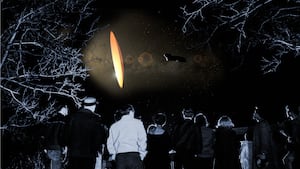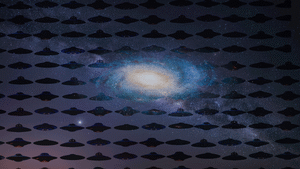A lot of serious scientists are searching for signs of alien life. Most of them are looking really, really far away—often in other star systems. But Harvard physicist Avi Loeb is looking nearby, in the air and space around Earth.
As part of his two-year-old Galileo Project, Loeb is steadily building a global network of telescopes and other sensors specifically for monitoring the atmosphere and near-space in order to detect visiting alien craft—a prerequisite for sending our own craft to meet E.T.
Loeb is also organizing expeditions to recover any pieces of alien spacecraft that have already crashed on Earth. “The Galileo Project is a scientific search program for potential astro-archaeological artifacts or remnants of extraterrestrial technological civilizations, or potentially active extraterrestrial equipment near Earth,” Loeb told The Daily Beast.
Contrast that with SETI, the “Search for Extraterrestrial Intelligence”—a field of research that mostly involves using huge radio receivers to listen for subtle signals that could be messages from distant alien civilizations. SETI searches for signals. Loeb’s Galileo searches for hardware.
Alien tech near Earth could take several forms, Loeb explained. There could be bits and pieces of very old alien probes from extinct civilizations. Probes that, after potentially millions of years spinning around our planet getting fried by radiation and pummeled by meteors, might look a lot like rocks—but aren’t rocks.
Those fragments of alien tech might occasionally plummet to Earth. Loeb said he’s especially interested in a meteorite that crashed into the Pacific Ocean near Papua New Guinea in 2014. Data from U.S. military sensors indicates the 1.5-foot-wide object was traveling faster than a typical meteorite, which in turn hints that the thing—whatever it is—originated from outside the solar system. The same data implied the meteorite was made of unusually tough material.
The object’s speed and composition tickled Loeb’s curiosity. An alien probe—at least, the remains of one—might be moving really fast as it traveled from one star system to the next. It would have to be made of very tough stuff in order to survive the journey.
To prove or disprove his suspicions, Loeb has secured funding to go look for the meteorite next year. “The Galileo Project,” he said, “plans an expedition to retrieve the fragments of this meteorite from the ocean floor in an attempt to determine the composition and potentially the structure of this unusual object—and study whether it was natural or artificial in origin.”
The Papua New Guinea meteorite isn’t the only one with weird characteristics that might point to artificial origins. B.P. Embaid, a physicist at Central University of Venezuela, has drawn attention to separate meteorites that landed in India in 1852 and in Arizona in 1850. Both include high concentrations of super-conductive compounds—heideite and brezinaite, respectively—that Embaid claimed could be artificially created.
It’s one thing to scrutinize a lump of metallic rock for possible alien origins. It would be another thing—and much more convincing to the wider scientific community—to find an intact, and functioning, alien probe.
Loeb posited it’d be controlled by artificial intelligence. A.I. “would be a natural choice for crossing the tens of thousands of light years that span the scale of the Milky Way galaxy and could exist even if the senders are not alive to transmit any detectable signals at this time.”

A very deep combined image shows the interstellar asteroid ‘Oumuamua at the center of the picture. This image was created by combining multiple images from ESO’s Very Large Telescope as well as the Gemini South Telescope.
ESO/K. Meech et al.It’s possible we already encountered such a probe, but didn’t realize it at the time. Five years ago a very strange object made a very strange journey across the solar system. Shiny, oblong, potentially 3,000 feet in length and moving at a speedy 16 miles a second, the object zoomed into the solar system and past the sun. When Canadian astronomer Robert Weryk first noticed the thing in a telescope survey in October 2017, it was already on its way out of our system.
Astronomers named the object ‘Oumuamua, Hawaiian for “scout.” No one knew for sure what ‘Omuamua is—or isn’t. Only Loeb was willing to say what others may only have been thinking. ‘Oumumua’s speed, course and shape are possible signs it’s an alien craft.
To Loeb, ‘Oumuamua was a missed chance to make first contact. Maybe. He’s determined not to miss the next chance. “The Galileo Project aims to design a space mission that will intercept or rendezvous with the next ‘Oumuamua and get high-quality data that would allow us to decipher its nature,” he said.
But organizing a space mission to the next potential alien craft first requires that we detect that craft—and detect it far enough in advance of its arrival near Earth that we have time to prepare our own probe. What we need is a network of sensors that constantly monitor the sky and space for nearby, fast-moving objects.
They don’t have to be huge, sophisticated and expensive instruments like the 28-foot-diameter telescope and 3.2-gigapixel camera at the new Vera Rubin Observatory that’s under construction on a mountaintop in Chile. Although to be fair, Loeb said Galileo aims to borrow data from Rubin once the observatory goes operational in around a year.
No, what Galileo needs is loose, around-the-clock monitoring of huge swathes of sky, rather than an occasional and detailed look at a very small part of the sky. “We are buying some cameras off-the-shelf from manufacturers and have our own engineers design their assembly, integration, calibration and operation,” Loeb explained.

Artist's concept of interstellar object1I/2017 U1 ('Oumuamua) as it passed through the solar system after its discovery in October 2017.
ESO/M. KornmesserThe first Galileo installation—for security reasons, Loeb wouldn’t say where—went live “in recent weeks.” It includes infrared and optical sensors, a passive radar system and audio receivers sensitive to the entire sonic range from infrasound to ultrasound, and can watch and listen to an entire hemisphere of the sky, nonstop. “The data is fed to a computer system which uses an A.I. algorithm to identify the objects,” Loeb said.
It’s an ambitious system, but Jacob Haqq Misra—an astrobiologist with the Blue Marble Space Institute of Science in Seattle who isn’t involved in Galileo—told The Daily Beast he believes it to be a sound one. “From a technical standpoint, the Galileo Project is doing the right experiment to identify aerial anomalies, whatever they end up being,” he said.
If you’re optimistic about first contact, like Loeb is, all this effort is obviously worth it. But even if you’re skeptical, and think we might be alone in the universe, there are good reasons to support Galileo. The project can do other things besides search for nearby aliens.
It is, in part, a surveillance system for Earth’s sky and nearby space. And once it’s complete, it’ll be the only hemispheric surveillance system that doesn’t belong to one military or another. “You can look for anything in the sky,” Misra said. Space debris, meteorites, aliens, whatever.








